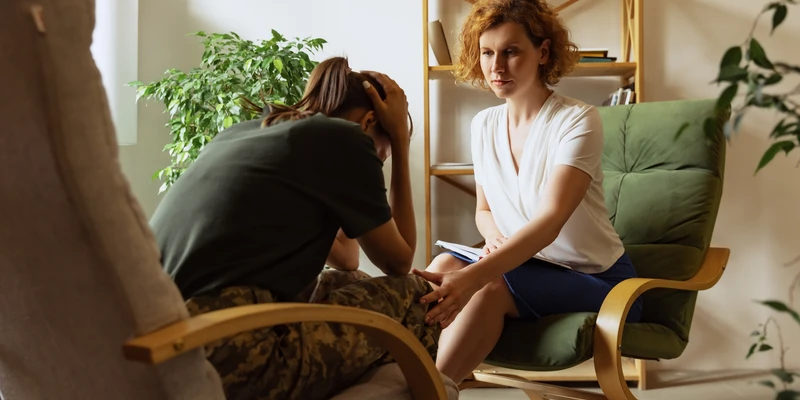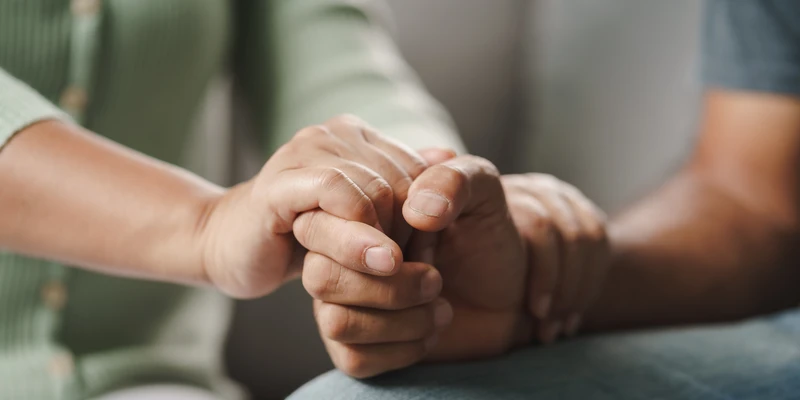- Defining PTSD and Its Symptoms
- What Is Cognitive Behavioural Therapy?
- Core Principles and Effectiveness of CBT Therapy for PTSD
- Types of CBT Used to Treat PTSD
- CBT Techniques and Interventions for PTSD
- What to Expect During CBT Therapy for PTSD
- Considerations and Alternative Approaches
- PTSD Treatment at Sierra Recovery
If you’re living with post-traumatic stress disorder (PTSD), the constant weight of nightmares, flashbacks, and sudden waves of panic can feel unbearable. One of the most effective and compassionate approaches available is Cognitive Behavioural Therapy (CBT). CBT therapy for PTSD gives you the proper tools so you can begin to untangle the hold trauma has on your daily life.
Defining PTSD and Its Symptoms
PTSD develops after you’ve experienced trauma such as an accident, assault, natural disaster, or combat. These events can overwhelm your ability to cope and create lasting psychological pain.
The symptoms of PTSD often include intrusive memories, flashbacks, nightmares, hyperarousal, and overwhelming fear. Many individuals with PTSD avoid reminders of the trauma, withdraw from others, or develop negative thoughts about themselves and the world. These PTSD symptoms can disrupt sleep, concentration, and relationships.
If left untreated, PTSD may worsen over time. But with the right treatment strategies, PTSD can be managed and even overcome. Recovery is not about forgetting what happened, but about making it possible for PTSD to be successfully treated through therapies like CBT.

What Is Cognitive Behavioural Therapy?
CBT is a structured and evidence-based psychological treatment that is widely recommended for the treatment of PTSD. It’s considered a first-line treatment in many healthcare systems because it helps people understand the relationship between their thoughts, feelings, and behaviours after a traumatic event.
A typical course of CBT includes 12–20 therapy sessions, where you and your therapist set clear goals. The focus is on the here and now: identifying patterns of thought that keep trauma-related distress going.
This type of talking therapy may involve learning coping skills, relaxation exercises, or grounding techniques. It can be delivered one-to-one, as CBT in a group, or even as online CBT, which helps to eliminate barriers to treatment retention for those who can’t easily access in-person support.
Core Principles and Effectiveness of CBT Therapy for PTSD
CBT is widely seen as the main treatment for PTSD because it focuses on changing the patterns that keep symptoms going. The trauma treatment protocol typically includes both thought-based and behaviour-based strategies.
Key Principles of CBT for Trauma
At its core, CBT teaches you to identify and challenge unhelpful beliefs. Through cognitive restructuring, you test whether your thoughts are realistic and reframe them into healthier alternatives. Alongside this, you practise coping skills, relaxation, and self-care.
Elements of trauma-focused CBT often include:
- Exposure therapy to reduce avoidance
- Cognitive restructuring to shift unhelpful thoughts
- Coping skills and grounding strategies
- Relaxation training for anxiety
Evidence and Success Rates
Research supports the effectiveness of CBT treatment for PTSD. One study reviewed 33 trials with over 6,400 adults to see how well CBT works for PTSD in everyday clinical settings.
It found that CBT led to large reductions in PTSD symptoms both after treatment and at six-month follow-up. Results in real-world care were almost identical to those from tightly controlled efficacy trials, showing strong consistency.
CBT Compared to Other Therapies
CBT is known for its structured, skills-based approach. Compared to other trauma treatments like EMDR (eye movement desensitisation and reprocessing) and DBT (dialectical behaviour therapy), CBT usually offers clearer, more practical steps for working through trauma.
Supportive counselling, group therapy, and medication can also play a role. However, CBT stands out as the therapy that focuses on thoughts and behaviours, making it the most consistently recommended for trauma recovery.

Types of CBT Used to Treat PTSD
There are a few different kinds of CBT for PTSD, each with its own twist. Some go straight for the traumatic memories; others help you shift unhelpful beliefs or manage tough symptoms.
Trauma-Focused CBT
Trauma-focused cognitive behavioural therapy (TF-CBT) is an evidence-based form of therapy for PTSD. The primary aim is to process painful trauma memories in a safe and supportive environment, allowing individuals to regain a sense of control.
This approach combines the structure of classic CBT with trauma-specific techniques, including gradual exposure therapy, skill-building, and relaxation training. Sessions help patients recognise how trauma has influenced their thoughts, emotions, and behaviours.
Cognitive Processing Therapy (CPT)
Cognitive Processing Therapy (CPT) is a specialised form of CBT that focuses on shifting negative beliefs formed after trauma. The approach helps individuals understand how trauma has altered their perceptions of themselves, others, and the world around them.
CPT typically involves writing about the trauma and discussing it in depth with a qualified therapist. A strong emphasis is placed on challenging beliefs rooted in self-blame or the perception that the world is inherently unsafe.
Prolonged Exposure (PE)
Prolonged Exposure (PE) therapy is a highly structured form of CBT treatment that helps individuals directly confront trauma reminders instead of avoiding them. Avoidance can maintain PTSD symptoms, but gradual, safe exposure reduces fear and distress over time.
PE sessions often include “imaginal exposure,” where the individual recounts the traumatic event in detail, as well as “in vivo exposure,” where real-life situations linked to trauma are faced step by step.
Cognitive Therapy (CT)
Cognitive therapy (CT) is another form of cognitive behavioural treatment that addresses the persistent, distressing thoughts that maintain PTSD. Its primary aim is to help individuals make sense of what happened and correct misinterpretations that contribute to ongoing distress.
During sessions, you and your therapist explore evidence for and against the beliefs you hold about the trauma, often focusing on feelings of guilt, shame, or responsibility. CT incorporates tools such as diaries, thought records, and behavioural experiments, alongside coping strategies and stress management techniques.
CBT Techniques and Interventions for PTSD
CBT brings a bunch of practical tools to the table for managing PTSD. These techniques help you shift negative thoughts, face tough memories, and build up your coping skills.
Cognitive Restructuring
Cognitive restructuring is a central element of CBT. It focuses on identifying and challenging unhelpful thoughts that maintain PTSD symptoms such as fear, anger, guilt, or sadness.
With the help of a therapist, you learn to examine whether your automatic thoughts truly reflect reality. This process, sometimes described as “detective work,” allows you to question false assumptions and gradually replace them with healthier perspectives.
Exposure Therapy Approaches
Exposure therapy is another highly effective method used in the treatment of PTSD. Avoidance often keeps distress alive, but safe, structured exposure helps retrain the brain to understand that trauma reminders are not inherently dangerous.
This can involve imaginal exposure, where you recount the traumatic event in detail, or in vivo exposure, where you gradually face avoided situations in everyday life. Therapists use prolonged exposure and other methods to keep things safe. It’s always at your pace, with solid support if you get overwhelmed.
Developing a Trauma Narrative
Building a trauma narrative means telling your story about what happened. You write or talk through the event, including your thoughts and feelings, then and now.
This helps you organise memories that might feel jumbled or chaotic. As you put your story together, you start to feel more in control, rather than letting painful memories run the show. Your therapist is there to guide you, ask questions, and help you connect your reactions and beliefs to the trauma.
Coping Skills and Strategies
CBT also equips you with a wide range of coping tools to support the management of PTSD symptoms outside of sessions. These skills may include breathing exercises, grounding techniques, relaxation strategies, or journalling to process emotions safely.
Your CBT therapist will work with you to create a personalised coping plan, helping you feel more prepared to handle stress, triggers, and setbacks. Over time, these strategies contribute to sustained treatment effects, making it possible for PTSD to be successfully managed in the long term.

What to Expect During CBT Therapy for PTSD
CBT therapy for PTSD is a structured therapy that tackles the way trauma messes with your thoughts and feelings. It’s evidence-based and aims to help you manage PTSD, depression, and anxiety by breaking those unhealthy cycles.
Assessment and Goal Setting
In the early sessions, your CBT therapist learns about your history and how trauma affects your life. Together, you’ll create a treatment plan with goals like reducing nightmares or managing anxiety.
Trust is vital. The therapy may feel scary at times, but a strong relationship with your therapist can help guarantee support. This will also make you feel more open to treatment.
Structure of CBT Sessions
CBT is highly structured. Each CBT session lasts about an hour, with progress check-ins, skills practice, and homework.
This structured course of CBT may include cognitive processing therapy exercises or exposure work. The goal is always to apply what you learn in real life, as that’s how CBT addresses core symptoms.
Common Barriers and Solutions
Living with PTSD can make therapy feel overwhelming. When you are experiencing PTSD symptoms, progress might feel slow.
Open communication and pacing help reduce the risk of setbacks. A good therapist knows how to adapt so you can continue to get treatment at a safe speed.
Considerations and Alternative Approaches
If you’re dealing with PTSD, treatment plans sometimes need a little extra tailoring—especially if there’s more going on than just trauma. Other therapies besides CBT are out there, and it’s worth knowing how to keep progress rolling after therapy ends.
CBT and Co-Occurring Conditions
It is common for people with PTSD to also experience depression, anxiety, bipolar disorder, or even schizophrenia. When more than one mental health condition is present, therapy must be carefully adapted. Your therapist may need to address overlapping symptoms and thought patterns that can become complicated, especially with conditions like bipolar disorder or psychosis.
PTSD is also closely linked with substance use disorder, as some may turn to alcohol or drugs in an attempt to manage overwhelming emotions or memories. In these cases, treatment often needs to address both trauma and substance use together, so that progress in one area supports recovery in the other.
Alternatives to CBT for PTSD
Although CBT is highly effective, it isn’t the only option. EMDR uses guided eye movements to help reprocess trauma memories. Some individuals find EMDR particularly helpful when traditional talking therapy alone doesn’t reduce symptoms.
DBT is another approach, especially when PTSD is accompanied by strong emotions, self-harm urges, or mental health problems related to emotional regulation.
Medication and group therapy may also play a role, and your mental health professional can recommend what combination of treatments best fits your situation.
Maintaining Progress After Therapy
Finishing a course of CBT or another trauma-focused approach doesn’t mean the work ends. Maintaining progress is about continuing to use the coping skills you’ve learned.
Some people schedule “booster” sessions with their therapist to reinforce progress, while others benefit from journalling or talking with trusted friends.
Support groups, whether in-person or through online therapy communities, provide valuable connections with others who understand what it means to be living with PTSD. Regular follow-up appointments can also be an important part of sustaining recovery, ensuring that your quality of life remains steady over time.
PTSD Treatment at Sierra Recovery
A traumatic event can deeply affect every part of your life. It can affect your sense of safety and your ability to move forward. At Sierra Recovery, we offer specialised, evidence-based CBT for PTSD.
Our team of compassionate clinicians will work closely with you to create a treatment plan that addresses your unique needs. Healing doesn’t happen overnight, but with the right support, it is possible.
You deserve to live a life not defined by trauma. Let us help you take the first step toward lasting healing and reclaiming your future.
Frequently Asked Questions
How does CBT differ from other psychological therapies for PTSD?
CBT is more structured and skills-focused than many other approaches. It directly targets the thought patterns and behaviours that maintain trauma symptoms, making it one of the most widely recommended psychological therapies for PTSD.
Can CBT prevent PTSD if started soon after trauma?
Early intervention with CBT may lower the risk of developing PTSD by teaching coping strategies before distress becomes entrenched. This approach focuses on managing immediate symptoms and building resilience.
Does CBT address physical symptoms linked to PTSD?
Yes. Many people with PTSD experience physical symptoms such as a racing heart, sweating, or startled responses. CBT teaches relaxation and grounding skills to calm the body alongside the mind.
Can CBT be combined with other therapies for more complex cases of PTSD?
Yes. In complex cases, CBT may be paired with approaches like mindfulness, pharmacological support, or other psychological therapies. This integrated approach provides broader tools for recovery.
Is CBT covered by the NHS or health insurance for the treatment of PTSD?
Yes. In the UK, the NHS often provides CBT as part of standard PTSD treatment, and many insurance providers cover it as a recommended first-line treatment.
How is progress measured during CBT for PTSD?
Therapists may use questionnaires, mood charts, or regular check-ins to monitor changes in PTSD symptoms. This way, the treatment continues to reflect what each person specifically requires.







